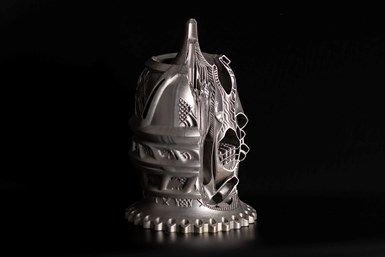EOS, Hyperganic Collaborate on Design, Performance of Space Propulsion Components
By creating a truly digital workflow, the companies aim to utilize additive manufacturing’s design freedom to create part structures and applications that were impossible to manufacture using traditional production processes.

Aerospike nozzle has a Hyperganic-enabled, software-generated algorithmic design, manufactured on an EOS M 400-4 system with the new, support-free NickelAlloy IN718 process and the new optimized flow nozzle. Photo Credit: EOS and Hyperganic
EOS is partnering with Hyperganic to advance the field of space propulsion by elevating the design and performance of space propulsion components. The collaboration includes the integration of Hyperganic Core — an AI-powered algorithmic engineering software platform — with EOS’ digital, additive manufacturing (AM) solutions.
“We are now partnering with Hyperganic to introduce another paradigm shift in AM. It is a design shift that expands solution spaces as well as performance levels,” says Dr. Hans J. Langer, EOS founder. “At the same time, it will revolutionize the design process for AM, making AM a truly digital workflow from software-generated algorithmic engineering to digital manufacturing.”
According to the companies, this collaboration is an industry first. “Algorithmic engineering translates ideas into designs in minutes, with the engineer setting the rules and the computer generating the results,” says Lin Kayser, Hyperganic CEO. “Specifically, the field of space propulsion, which still uses very conservative designs, will benefit greatly from algorithmic engineering.”
AM has been noted for revolutionizing design freedom. Traditional production processes utilizing CAD designs can still require laborious remodeling work for changes, the companies say. With every iteration costing time and money, CAD-based approaches may compel engineers to design conservatively instead of pushing the limits. Now, AM’s design freedom is said to enable part structures and applications that were impossible to manufacture using traditional production processes. The partnership between EOS and Hyperganic aims to take this approach to the next level.
One example is the aerospike rocket engine designed by Hyperganic and manufactured by EOS and AMCM, an EOS Group company. The aerospike engine was built from the ground up using an algorithmic model by Hyperganic. One of the hundreds of designs produced by Hyperganic in just days was printed on an EOS M 400-4. The complex part was printed with no supports using the newly developed EOS NickelAlloy IN718 process.
Consequently, the aerospike engine was automatically re-engineered for production on a substantially larger AMCM M 4K from AMCM in EOS CopperAlloy CuCrZr. The combination of this level of design complexity with the capability to print in this size in a reliable manner, will drive the next innovations in space propulsion, the companies say.
Related Content
-
Solving 3D Printing’s Hidden Problem: Vibration
Ulendo’s vibration compensation software can double the speed of FFF 3D printers while maintaining part quality, all without changing the machine’s hardware.
-
3D Printed Cutting Tool for Large Transmission Part: The Cool Parts Show Bonus
A boring tool that was once 30 kg challenged the performance of the machining center using it. The replacement tool is 11.5 kg, and more efficient as well, thanks to generative design.
-
To Scale Additive Manufacturing, Separate Design and Production
Spokbee’s online marketplace is designed to ease the launch and sale of customizable, 3D printed products. Its flexibility comes from cloud-based CAD and a distributed network of service bureaus for production.












.png;maxWidth=300;quality=90)

